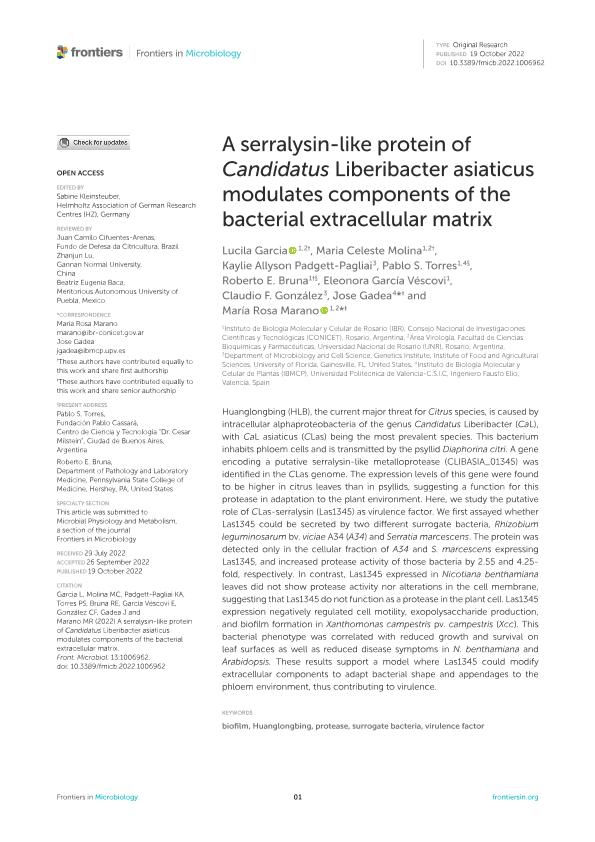Artículo
A serralysin-like protein of Candidatus Liberibacter asiaticus modulates components of the bacterial extracellular matrix
García, Lucila ; Molina, Maria Celeste
; Molina, Maria Celeste ; Padgett Pagliai, Kaylie Allyson; Torres, Pablo Sebastian
; Padgett Pagliai, Kaylie Allyson; Torres, Pablo Sebastian ; Bruna, Roberto Emanuel
; Bruna, Roberto Emanuel ; Garcia Vescovi, Eleonora
; Garcia Vescovi, Eleonora ; González, Claudio F.; Gadea, Jose; Marano, María Rosa
; González, Claudio F.; Gadea, Jose; Marano, María Rosa
 ; Molina, Maria Celeste
; Molina, Maria Celeste ; Padgett Pagliai, Kaylie Allyson; Torres, Pablo Sebastian
; Padgett Pagliai, Kaylie Allyson; Torres, Pablo Sebastian ; Bruna, Roberto Emanuel
; Bruna, Roberto Emanuel ; Garcia Vescovi, Eleonora
; Garcia Vescovi, Eleonora ; González, Claudio F.; Gadea, Jose; Marano, María Rosa
; González, Claudio F.; Gadea, Jose; Marano, María Rosa
Fecha de publicación:
10/2022
Editorial:
Frontiers Media
Revista:
Frontiers in Microbiology
ISSN:
1664-302X
Idioma:
Inglés
Tipo de recurso:
Artículo publicado
Clasificación temática:
Resumen
Huanglongbing (HLB), the current major threat for Citrus species, is caused by intracellular alphaproteobacteria of the genus Candidatus Liberibacter (CaL), with CaL asiaticus (CLas) being the most prevalent species. This bacterium inhabits phloem cells and is transmitted by the psyllid Diaphorina citri. A gene encoding a putative serralysin-like metalloprotease (CLIBASIA_01345) was identified in the CLas genome. The expression levels of this gene were found to be higher in citrus leaves than in psyllids, suggesting a function for this protease in adaptation to the plant environment. Here, we study the putative role of CLas-serralysin (Las1345) as virulence factor. We first assayed whether Las1345 could be secreted by two different surrogate bacteria, Rhizobium leguminosarum bv. viciae A34 (A34) and Serratia marcescens. The protein was detected only in the cellular fraction of A34 and S. marcescens expressing Las1345, and increased protease activity of those bacteria by 2.55 and 4.25-fold, respectively. In contrast, Las1345 expressed in Nicotiana benthamiana leaves did not show protease activity nor alterations in the cell membrane, suggesting that Las1345 do not function as a protease in the plant cell. Las1345 expression negatively regulated cell motility, exopolysaccharide production, and biofilm formation in Xanthomonas campestris pv. campestris (Xcc). This bacterial phenotype was correlated with reduced growth and survival on leaf surfaces as well as reduced disease symptoms in N. benthamiana and Arabidopsis. These results support a model where Las1345 could modify extracellular components to adapt bacterial shape and appendages to the phloem environment, thus contributing to virulence.
Palabras clave:
BIOFILM
,
HUANGLONGBING
,
PROTEASE
,
SURROGATE BACTERIA
,
VIRULENCE FACTOR
Archivos asociados
Licencia
Identificadores
Colecciones
Articulos(IBR)
Articulos de INST.DE BIOLOGIA MOLECULAR Y CELULAR DE ROSARIO
Articulos de INST.DE BIOLOGIA MOLECULAR Y CELULAR DE ROSARIO
Citación
García, Lucila; Molina, Maria Celeste; Padgett Pagliai, Kaylie Allyson; Torres, Pablo Sebastian; Bruna, Roberto Emanuel; et al.; A serralysin-like protein of Candidatus Liberibacter asiaticus modulates components of the bacterial extracellular matrix; Frontiers Media; Frontiers in Microbiology; 13; 10-2022; 1-19
Compartir
Altmétricas



